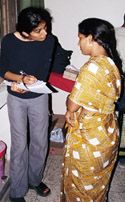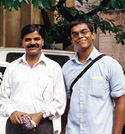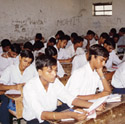|
|
|

Mira Shah interviews a patient at the Jahangirpuri Outreach Clinic
in Dehli
photo by Siva Ambalam
|
|
|
|

Siva Ambalam, right, with Sushil Sharma, a clinical assistant who
helped Ambalam and Shah with their survey and translated it into
Hindi
|
|
|
|

High school boys at the C-2 Government School in Dehli complete
the aids survey done by Ambalam and Shah
|
|
|
|
|
| |
|
|
| |
|
|
|
Passage to India
Siva Ambalam (WCAS01) and Mira Shah sit in a rickshaw under the merciless
early morning sun, caught in Delhi, India’s rush-hour traffic. Small
cars, combine-size trucks, mopeds, bicycles, buses and other rickshaws
try to maneuver on the
two-lane dirt road, where traffic laws are paid no heed. The street swarms
with forceful street vendors and cows, India’s sacred animal. The
pervasive smell of
jasmine flowers mixed with the foul odor of open sewers fills the air.
Ambalam and Shah will see four or five accidents on their way to the elementary
school, where they are conducting research on HIV/AIDS awareness.
When they walk into the school, all of the uniformed students rise out
of respect for their elders. Between the crumbling, concrete walls of
the classroom, the students studied three to a two-person bench. Everywhere
Ambalam and Shah turned during their trip to Delhi, they were surrounded
by oppressive crowds and abject poverty. But despite these conditions,
Ambalam says, Indians have an amazing will to survive and thrive.
It was a Northwestern undergraduate research grant that allowed Ambalam,
who studied biological sciences, and Shah, an Asian studies major, to
do their research in mental health clinics and elementary schools in Delhi
last summer.
However, the two students didn’t just come back with data. They returned
with enthralling stories, riveting images, life lessons and a renewed
sense of appreciation for the lives they lead in the United States.
Before they left, Ambalam and Shah were determined to survey adults and
young people in India about their knowledge of an epidemic that is ravaging
the world, especially developing nations. They got approval from the Indian
government to ask such questions as "What is HIV/AIDS?" "How
do you think HIV is spread?" "What are condoms used for?"
and related queries.
Ambalam and Shah arrived unaccompanied, with no professor or government
official to guide them. They moved into a banquet hall that doubled as
a hotel, where they were welcomed by being kept up all hours of the night
by music so loud it made the walls vibrate. The heat was unbearable (well
over 100 degrees every day), but the first time Ambalam turned on his
air conditioner, a huge burst of flames came out. Shah woke up the first
morning covered in bites from bedbugs. And both developed health problems.
Actually these would be the least of their worries. Straightaway Ambalam
and Shah ran into clearance problems after the government rescinded many
of its earlier promises about where the students could do their surveys.
After about a week of delays and compromise on both sides, Ambalam and
Shah started distributing surveys in classrooms to children and to patients
at mental health clinics. Many of the latter were street dwellers trying
to get their lives on track after years of drug use.
With the help of an interpreter, the two collected some striking data.
"Some people thought you could contract AIDS from sharing a glass
of water with someone who is infected, while others understood that if
you practice safe sex and have a relationship where both partners are
loyal, you can avoid contracting the disease," Ambalam says.
Ambalam and Shah found that, contrary to what one might expect, Indian
schoolchildren knew next to nothing about AIDS, while uneducated homeless
people tended to be rather well informed. The researchers attribute this
paradoxical situation to the impact of the country’s culture on children’s
sex education. Discussing sex is basically taboo in India’s schools.
"Tenth- and 12th-grade girls were asking us what sex was, while street
dwellers who were totally uneducated talked to us about how AIDS spreads
and how it is prevented," Shah says.
Although Ambalam and Shah were in Delhi to do AIDS research, the time
they spent in clinics gave the two a whole education on public health
problems in India, such as drug use. They constantly listened to life
stories filled with misery and hardship.
"Sometimes when we left the clinic, I had forgotten all about our
survey," Shah says. "All I could think of was the people we
had met and interviewed and what information they had humbly shared with
us."
One man who answered the survey made an indelible impression on Shah.
Repeatedly calling her "doctor" throughout the interview, he
pleaded afterward with her to help him find a job. Shah felt helpless
because she had no way of assisting him.
Partly as a result of their Delhi experience, both students are seriously
considering careers in public health. Since October Ambalam has been working
for Evanston Northwestern Healthcare, doing quality-of-life research on
cancer patients. In January he started a master’s degree program
in public health and hopes to follow that up with medical school. Shah,
a senior, is planning on working in a lab this summer. They are currently
collaborating on a paper on their research, which they will submit either
to an Indian or a U.S. social science journal.
While Ambalam and Shah have yet to fully compile all of their data, what
is certain is that they both came back to the United States with a new
appreciation for our culture.
"My time in India was one of the defining points in my life,"
says Ambalam. "I learned to appreciate the opportunities I have on
a daily basis. … I truly feel lucky to be living in America."
— E.R.
RETURN TO FEATURE STORY
|

